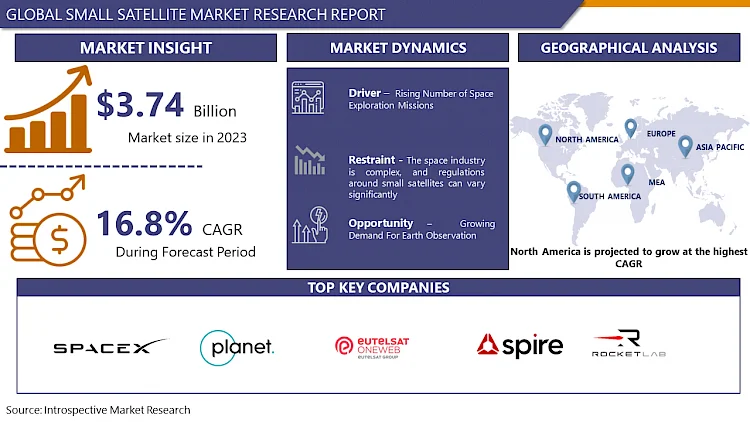Small Satellite Market Size Was Valued at USD 3.74 Billion in 2023, and is Projected to Reach USD 15.13 Billion by 2032, Growing at a CAGR of 16.8% From 2024-2032.
The space industry is undergoing a dramatic transformation, driven primarily by the rise of small satellites. These compact, cost-effective spacecrafts are revolutionizing how we utilize space for various applications, from communication and Earth observation to scientific research and national security.
What are Small Satellites?
Small satellites, as the name suggests, are significantly smaller and less expensive to build and launch compared to traditional satellites. They typically range from a few kilograms to hundreds of kilograms. This category encompasses a wide spectrum of spacecraft, including CubeSats, nanosatellites, microsatellites, and minisatellites.
For more insights on the historical and Forecast market download a sample report https://introspectivemarketresearch.com/request/16765
The Top Key Players Covered in This Market are:
SpaceX (USA), Planet Labs (USA), Blue Origin (USA), OneWeb (UK), Spire Global (USA), Rocket Lab (USA/New Zealand), BlackSky (USA), Airbus Defense and Space (France), Lockheed Martin (USA), Northrop Grumman (USA), Boeing (USA), Surrey Satellite Technology Ltd (UK), ISRO (Indian Space Research Organisation) (India), Thales Alenia Space (France/Italy), Mitsubishi Electric Corporation (Japan), Ball Aerospace (USA), NanoRacks (USA), Axelspace Corporation (Japan), Virgin Orbit (USA), Terran Orbital (USA), AAC Clyde Space (Sweden), China Aerospace Science and Technology Corporation (China), GomSpace (Denmark), Clyde Space (UK), Tyvak Nano-Satellite Systems (USA), and Other Major Players
Driving Forces Behind the Market Growth
Several factors are propelling the growth of the small satellite market:
Decreasing launch costs: The advent of reusable rockets and the emergence of dedicated small satellite launch providers have drastically reduced launch costs, making space more accessible.
Technological advancements: Miniaturization of components and advancements in satellite technology have enabled the development of smaller, more capable spacecraft.
Diverse applications: Small satellites are finding applications across various sectors, including agriculture, disaster management, environmental monitoring, and internet connectivity.
Increased commercial interest: The potential for significant returns on investment is attracting private companies to invest in small satellite constellations.
Government support: Many governments are recognizing the strategic importance of small satellites and are investing in research and development.
Segmentation Analysis of Market:
By Type
- Minisatellite
- Microsatellite
- Nanosatellite
- Pico-Satellites
- Femtosatellites
By Orbit
- Low Earth Orbit (LEO)
- Middle Earth Orbit (MEO)
- Geostationary Earth Orbit (GEO)
By Component
- Structures
- Payload
- Electric Power System
- Solar Panel and Antenna Systems
- Propulsion Systems
By Application
- Earth Observation and Remote Sensing
- Satellite Communication
- Science and Exploration
- Mapping and Navigation
- Space Observation
By End- User
- Commercial
- Academic
- Government
- Military
Challenges and Opportunities
While the small satellite market presents immense opportunities, it also faces challenges:
Orbital debris: The increasing number of satellites in orbit raises concerns about space debris and potential collisions.
Regulatory framework: The rapid development of the industry necessitates clear and adaptable regulations to ensure safe and sustainable space operations.
Data management: Processing and analyzing the vast amount of data generated by satellite constellations requires advanced analytics capabilities.
Despite these challenges, the small satellite market is poised for significant growth in the coming years. The potential benefits for society are enormous, and the industry is expected to create new jobs and economic opportunities.
Studying the complete Small Satellite Market ecosystem, our study elaborates the interdependencies and functions of various market stakeholders. Through extensive segmentation analysis and comprehensive geographical coverage, we facilitate a profound comprehension of regional trends. Furthermore, we carefully analyse external factors that impact market dynamics. A Small Satellite Market aspect of our report is the comprehensive company profiles and competitive analysis. This provides invaluable insights into market players’ market role, overview, operating business segments, products, and financial performance. By evaluating crucial metrics like production volume, sales volume, and sales margin, we offer a comprehensive understanding of their market position.
Key Industry Developments in the Market:
- In March 2024, Rocket Lab’s Electron rocket successfully launched three collaborative research missions into low-Earth orbit from NASA’s Wallops Island Flight Facility, including the Mola CubeSat mission led by NPS’ SSAG. NPS’ contributions, the terahertz imaging camera (TIC) and LED on-orbit payload (LOOP), aim to advance free-space optical communications for CubeSats, while New Zealand’s Defence Science and Technology unit provided a radio transmitter. This marks a significant step forward in comms experimentation and international collaboration in space exploration.
- In March 2024, statically tested its communication and air traffic surveillance systems on a Nano Avionics-built satellite, paving the way for the first space-based air traffic service constellation. The International Telecommunication Union’s approval marks a significant step, allowing Statically to provide integrated space communication and surveillance services for air navigation worldwide. Utilizing a satellite from Kongsberg Nano Avionics, the project aims to assess VHF radio communication and ADS-B surveillance systems directly from space, with operations slated to begin in 2025.
- In September 2024, 23 companies showed interest in acquiring ISRO’s Small Satellite Launch Vehicle technology, according to IN-Space Chairman Pawan K Goenka, terming it a “tremendous response”. The autonomous agency under the Department of Space received the interest after floating an Expression of Interest in July. IN-SPACe aims to enable non-government entities to undertake space activities, with only one company set to acquire the SSLV technology.
Region and Country level Analysis:
- North America (U.S., Canada, Mexico)
- Eastern Europe (Bulgaria, The Czech Republic, Hungary, Poland, Romania, Rest of Eastern Europe)
- Western Europe (Germany, U.K., France, Netherlands, Italy, Russia, Spain, Rest of Western Europe)
- Asia-Pacific (China, India, Japan, South Korea, Malaysia, Thailand, Vietnam, The Philippines, Australia, New Zealand, Rest of APAC)
- Middle East & Africa (Turkey, Saudi Arabia, Bahrain, Kuwait, Qatar, UAE, Israel, South Africa)
- South America (Brazil, Argentina, Rest of SA)
Small Satellite Market Regional Insights:
North America is Expected to Dominate the Market Over the Forecast Period
- North American countries, particularly the United States, have a strong tradition of technological innovation and entrepreneurship. Many of the leading companies in the small satellite industry, such as SpaceX, Rocket Lab, and Planet Labs, are based in North America and have pushed the boundaries of what is possible with small satellite technology.
Target Audience of the Global Small Satellite Market in Market Study:
- Key Consulting Companies & Advisors
- Key manufacturers
- Large, medium-sized, and small enterprises
- Venture capitalists
- Value-Added Resellers
- Third-party knowledge providers
- Investment bankers
- Investors
Conclusion:
The small satellite market is a dynamic and rapidly evolving sector with the potential to transform various industries. As technology continues to advance and launch costs decline, we can expect to see even more innovative applications in the future.
About us:
Introspective Market Research Private Limited (introspectivemarketresearch.com) is a visionary research consulting firm dedicated to assist our clients grow and have a successful impact on the market. Our team at IMR is ready to assist our clients flourish their business by offering strategies to gain success and monopoly in their respective fields. We are a global market research company, specialized in using big data and advanced analytics to show the bigger picture of the market trends. We help our clients to think differently and build better tomorrow for all of us. We are a technology-driven research company, we analyze extremely large sets of data to discover deeper insights and provide conclusive consulting. We not only provide intelligence solutions, but we help our clients in how they can achieve their goals.
Get in Touch with Us:
Canada Office
Introspective Market Research Private Limited,138 Downes Street Unit 6203, M5E 0E4, Toronto, Canada.
APAC Office
Introspective Market Research Private Limited, Office No. 401-403, Saudamini Commercial Complex, Chandani Chowk, Kothrud, Pune, India-411038
Ph no: +1 773 382 1049
Email: sales@introspectivemarketresearch.com



